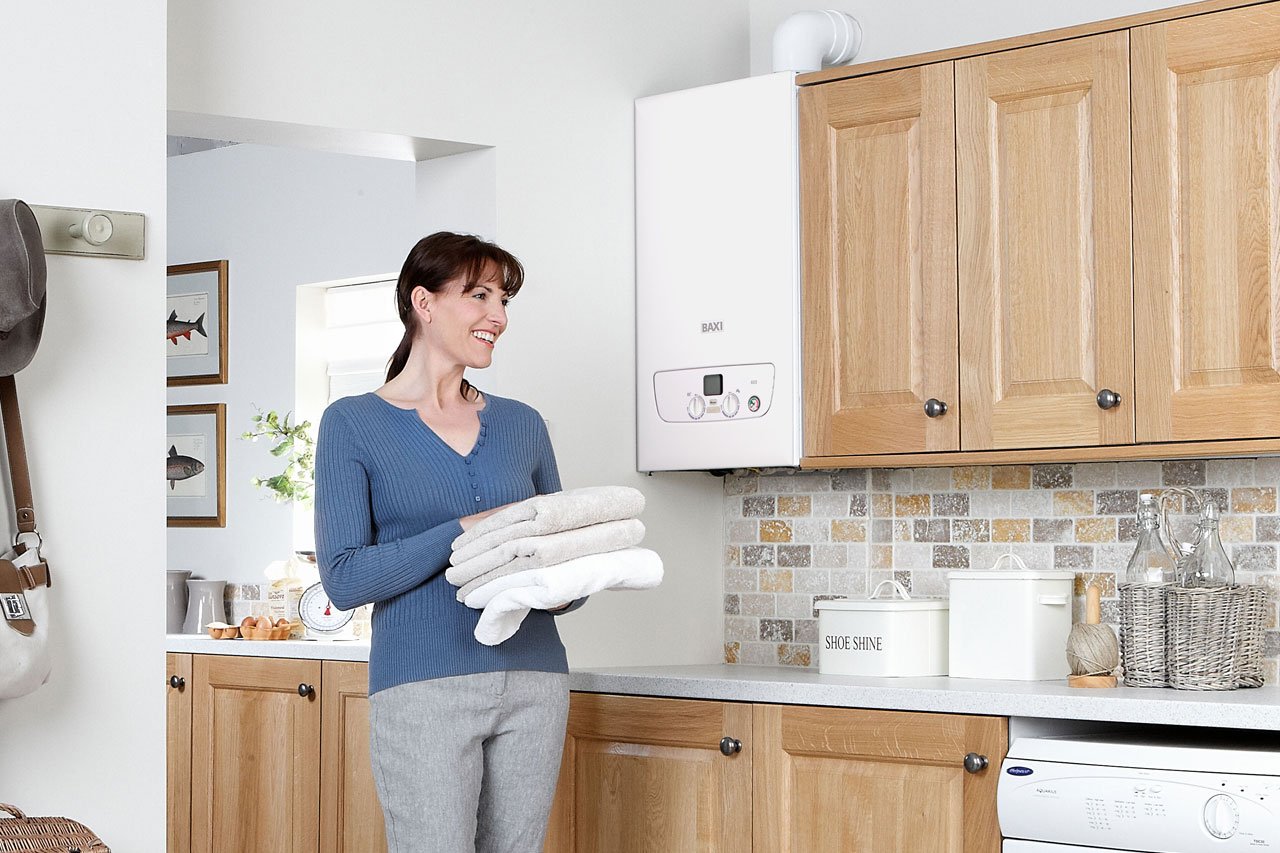Glossary
If DHW, Boiler Plus or ASHP sound like gobbledegook to you, check out our jargon buster. If you can’t find the term you are looking for, let us know and we’ll add it to our list.
A
Air source heat pump (ASHP)
An air source heat pump is a low-carbon way of heating your home. It absorbs latent heat from the outside air and uses it to increase the temperature inside your home. Air source heat pumps look similar to an air-conditioning unit. Its size depends on how much heat it needs to generate for your home -typically the more heat, the bigger the heat pump. Find out more here.
Annual service
Just like your car needs to have a service to make sure the brakes are safe and to change the oil, a boiler needs to be serviced every year by a Gas Safe registered engineer, to make sure it is running safely and efficiently. It is also a requirement of the warranty to have an annual service. Find out more here.
B
Back boiler unit (BBU)
A back boiler is a boiler fitted at the back of an open fireplace hearth. It usually sits behind a gas or electric fire (in the chimney breast) and provides hot water and central heating to the property.
BAR
A unit of pressure relating to water, gas or air.
Benchmark Checklist
Benchmark is a nationally recognised scheme that makes boiler manufacturers and installers responsible for best practice during installation, commissioning and servicing of domestic heating and hot water products in line with Building Regulations in England and Wales. It is managed and promoted by the Heating and Hot Water Industry Council (HHIC).
Benchmark requires installers to complete a Benchmark checklist when commissioning a new boiler. Failure to install and commission according to the manufacturer’s instructions and complete the Benchmark commissioning checklist will invalidate the warranty for gas boiler installations.
Bleeding the radiators
If there is air trapped in your central heating system, and the tops of your radiators are cooler than the rest, you may have to ‘bleed’ the radiator. This is easily done by using a radiator key to open the small valve at the top of the radiator to let the air out. When water starts to come out, the air is gone and you need to tighten the valve again. Check the pressure gauge on the boiler when you have bled the radiators, to see if you need to repressurise the system. Find out how to bleed a radiator in 8 simple steps .
Boiler Plus
Boiler Plus was part of the Building Regulations that became law on 6 April 2018. It applies to homes in England only. The main points are:
- Gas boilers must be at least 92% efficient
- Time and temperature controls must be fitted
- And one of the following must be installed with combi boilers: weather compensation; Load compensation; Flue Gas Heat Recovery; or Smart control with automation and optimisation’
Building Regulations (Part L)
Part L is the building regulation in England that sets the standards for the energy performance of new and existing buildings. When a new heating system is installed in a home it must comply with Part L of the Building Regulations.
C
Carbon dioxide (CO2)
A colourless, odourless gas produced by burning carbon and organic compounds and by respiration. It is naturally present in air (about 0.03 per cent) and is absorbed by plants during photosynthesis. It is a major component of greenhouse gas, responsible for global warming and climate change.
Carbon monoxide (CO)
A colourless, odourless, poisonous flammable gas formed when natural gas or LPG does not burn properly. If your boiler is not working correctly or your flue is blocked or badly fitted, carbon monoxide can accumulate in your home and it can poison or kill. This is one of the reasons why it is so important to have your boiler serviced every year and checked to make sure it is working safely. For more information please read our Carbon Monoxide advice.
Cold water mains
The water that comes from the water mains, directly into your home, under mains pressure.
Combination boiler (combi)
A boiler that provides central heating and also heats water instantly when you turn on a hot tap. It does not need a water storage cylinder or water tanks in the loft. The water it heats comes straight from the mains, so the flow rate at the tap is usually very good. Take a look at at our range of combi boilers here.
Condensate pipe
Condensing boilers remove so much of the heat from the flue gases that sometimes the water left in the gas condenses. This ‘condensate’ is discharged through a narrow plastic pipe called the condensate pipe. If the condensate pipe has been fitted outside and is not insulated, the water in it can freeze in very cold weather. This makes the boiler shut down to protect itself, and it can’t be restarted until the condensate pipe has been thawed. Our video shows how to thaw a frozen condensate pipe.
Condensing boiler
In 2005, UK Building Regulations were introduced to make it compulsory for all new gas boilers to be condensing. Condensing boilers use condensing technology to make better use of the heat they generate from burning fuels. All the domestic boilers sold today are condensing boilers, whether they are combi, system or heat only boilers.
Controls
Controls for your boiler or heating system include room thermostats, room programmers and digital or mechanical timers. Controls help you get the best out of your heating system and make it work efficiently and cost effectively.
Cylinder
The hot water storage cylinder supplies hot water that has been heated by a system or heat only boiler to the taps. It can also have an immersion heater, so it can be heated by electricity if the boiler is not switched on. Take a look at our range of cylinders here.
D
Domestic hot water (DHW)
The water that comes from your hot tap or is stored in a hot water cylinder.
E
Energy related Products (ErP)
The Energy-related Products Directive was introduced by the EU to phase out poorly performing products across a range of product groups to reduce carbon emissions across Europe. These include tyres, bulbs and shower heads, and since September 2015, it has also applied to residential and commercial heating products. Find out more here.
Expansion vessel
The expansion vessel is a small, pressurised container inside your boiler that accommodates the extra volume when the water in your heating system heats up and expands.
F
Feed and expansion tank
Usually found in open vented heating systems, two tanks can be found in the loft; the larger one feeds fresh water to the hot water storage cylinder and the other, smaller tank maintains the correct level of water in the heating system. The tanks also allow for the expansion of water when the system gets hot.
Flow rate
The rate at which water comes out of your tap – usually measured in litres per minute (LPM). If you have a lower flow rate, it will take a long time for your bath or sink to fill. Your heating engineer can recommend ways to increase your flow rate. If you have a combi boiler, the flow rate refers to how much hot water can be heated as it flows through the boiler, at a given rate, usually litres per minute. If you need large quantities of hot water, a system or heat only boiler, along with a cylinder, may be better for you than a combi.
Flue
The flue is a bit like an exhaust pipe, taking away the waste gases from the boiler’s burner. It also supplies air into the burner so the boiler can burn the best mix of gas and air, making it as efficient as possible. Flues are either concentric – they have one pipe inside the other – or twin pipe – one pipe takes the exhaust away and the other supplies air to the boiler.
Flue Gas Heat Recovery
Flue Gas Heat Recovery is a device that sits neatly between the boiler and the flue. It collects and recycles any remaining heat in the flue gas which would normally go through the flue, into the atmosphere and be wasted.
H
Heat exchanger
The heat exchanger in your boiler transfers the heat from burning gas to the water that circulates around your home through radiators and to either your hot water cylinder or, if you have a combi boiler, to your hot taps. Modern condensing boilers have heat exchangers that maximise their efficiency, helping to save you money on your energy bills.
Heat only boiler
Also known as a ‘conventional’ boiler. This type of boiler is often found in older homes and needs a feed and expansion tank in the loft to store cold water. It also needs a hot water storage cylinder, and a pump to circulate hot water around the central heating system. Take a look at our range of heat only Boilers here.
High efficiency boiler
A high efficiency boiler is the same as a condensing boiler (see above).
L
Liquid Petroleum Gas (LPG)
LPG is often used as a fuel for homes that are not on the main gas network and is stored in tanks near the properties. BioLPG is a new, more sustainable version of LPG with a greatly reduced carbon footprint.
Litres per minute (LPM)
The rate at which water comes out of your tap, also known as the flow rate (see above).
M
Magnetic filter/system filter
A magnetic filter can be fitted to your central heating system to protect it from sludge and rust that builds up over time. This debris can be harmful to your boiler and make your heating system less efficient. Find out more about magnetic boiler filter here.
O
Open Therm
Open Therm is the ‘language’ that Baxi’s compatible thermostats and boilers can use to ‘talk’ to each other and control the heating and hot water.
Open vented system
A heating system that has a feed and expansion tank in the loft (see Feed and expansion tank).
Output (kW)
The output of boilers is usually measured in kilowatts (kW). Your installer can determine the right output for your heating system by carrying out a survey of your home and your personal requirements. If you are having a combi boiler and require a lot of hot water, you will need a high output. However, if you have a system or heat only boiler, you will need the lowest output required to heat your radiators, because hot water will be stored in the cylinder.
P
Pilot light
Some old, standard efficiency boilers had a small flame, burning constantly, to ignite the burner when heating or hot water was required. Modern boilers don’t have pilot lights because they are lit by electronic ignition.
Power flush
A cleaning process that removes all the sludge and debris from your heating system. If you have cold spots on your radiators, they could be filled with sludge that has built up inside the system over many years. If you put a brand new boiler onto a dirty system, it could damage or block the heat exchanger.
Printed circuit board (PCB)
The PCB controls the boiler electronically. Sometimes, it will develop a fault or stop working properly, or sometimes it may shut down the boiler because another component is not working properly. Your heating engineer should check all the components before changing the PCB.
R
Room thermostat/programmable room thermostat
With a room thermostat, you can set the temperature for a room. With a programmable room thermostat, you can schedule the heating to come on at various times during the day or night at the right temperature to suit your requirements.
S
Smart meter
Smart meters give both you accurate and regular updates on how much electricity and gas you use and also send this information automatically to your energy supplier. The display on your smart meter shows how much energy you are using (in real time) and how much it's costing, to help you better control your energy use.
Smart thermostat
A smart thermostat connects your heating system to the internet, so you can schedule your heating, change the temperature or switch your heating off using an app on your smartphone or other device when you're out and about.
Standard efficiency/non-condensing
Old, non-condensing, or standard efficiency boilers can be as little as 60% efficient. Modern condensing boilers are over 90% efficient. So, replacing an old boiler can help you make substantial savings on your gas bills.
System boiler
A boiler that works with a hot water storage cylinder but does not generally need a tank in the loft to fill the system. Take a look at our range of system Boilers here.
T
Thermostatic radiator valves
Thermostatic radiator valves can be fitted to individual radiators so you can vary the temperature in each room, to suit your needs.
U
Unvented/sealed system
An unvented or sealed heating system does not need feed and expansion tanks in the loft. Instead, the system is filled with mains water through a filling loop and there is an expansion vessel in the boiler to accommodate the hot water as it expands in the system.
W
Weather compensation
An outdoor mounted weather compensation sensor works with the boiler to give greater fuel savings and improved comfort levels in the home.




